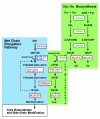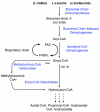Branched-Chain Amino Acid Metabolism in Arabidopsis thaliana
- PMID: 22303262
- PMCID: PMC3244963
- DOI: 10.1199/tab.0137
Branched-Chain Amino Acid Metabolism in Arabidopsis thaliana
Abstract
Valine, leucine and isoleucine form the small group of branched-chain amino acids (BCAAs) classified by their small branched hydrocarbon residues. Unlike animals, plants are able to de novo synthesize these amino acids from pyruvate, 2-oxobutanoate and acetyl-CoA. In plants, biosynthesis follows the typical reaction pathways established for the formation of these amino acids in microorganisms. Val and Ile are synthesized in two parallel pathways using a single set of enzymes. The pathway to Leu branches of from the final intermediate of Val biosynthesis. The formation of this amino acid requires a three-step pathway generating a 2-oxoacid elongated by a methylene group. In Arabidopsis thaliana and other Brassicaceae, a homologous three-step pathway is also involved in Met chain elongation required for the biosynthesis of aliphatic glucosinolates, an important class of specialized metabolites in Brassicaceae. This is a prime example for the evolutionary relationship of pathways from primary and specialized metabolism. Similar to animals, plants also have the ability to degrade BCAAs. The importance of BCAA turnover has long been unclear, but now it seems apparent that the breakdown process might by relevant under certain environmental conditions. In this review, I summarize the current knowledge about BCAA metabolism, its regulation and its particular features in Arabidopsis thaliana.
Figures




References
-
- Ahn HJ, Eom SJ, Yoon HJ, Lee BI, Cho H, Suh SW. Crystal structure of class I acetohydroxy acid isomeroreductase from Pseudomonas aeruginosa. J Mol Biol. 2003;3288(1):505–515. - PubMed
LinkOut - more resources
Full Text Sources
Other Literature Sources
Miscellaneous
